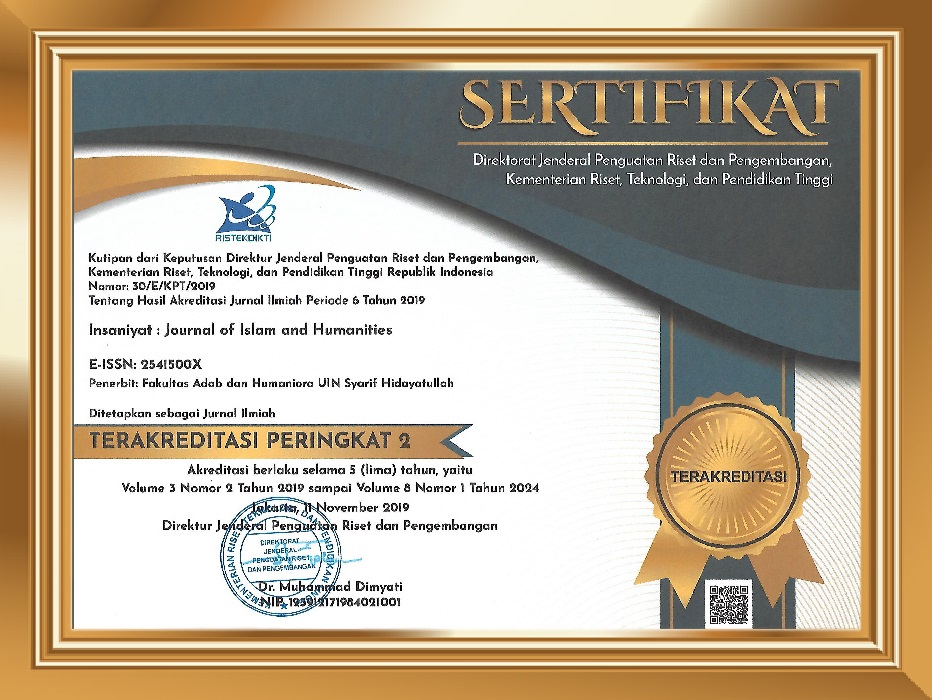A Cognitive Linguistic Approach to Life Metaphor in Tetralogy Laskar Pelangi
Abstract
This study aims at finding the use of life metaphors in tetralogy Laskar Pelangi (hereinafter TLP). Data were analyzed in the framework of the Conceptual Metaphor Theory (CMT) by using a descriptive qualitative approach. We found 21 life metaphors in TLP and the finding shows that the conceptual metaphor of life as a target domain is mapped into several diverse source domains, and they are: life is a fluid in a container, life is a journey, life is a living organism, life is a precious possession, life is dedication to others, life is a struggle,
life is guidance, life is war, and life is hard work. It can be concluded that TLP is rich with the use of metaphors in describing the cultural events of the Malays in detail. The way how the Malay master the problems in their lives, how they see and understand the world, is made clear by their language, which is reflected in conceptual metaphors. The results of this research support the idea that metaphors are not just rhetorical devices to say something more stylistically but they are conceptual in nature and its existence can be different in each culture.
Keywords
References
Bojovic, B. (2014) “Strategies of Metaphor Translation,” ELTA Journal, 2(2), p. 74–81.
Brown, A. (2018) “A Metaphorical Analysis of the Love Song of J. Alfred Prufrock by T.S. Eliot.,” Accounting Forum. Tersedia pada: https://doi.org/10.1016/j.accfor. 2018.01.006.
Burmakova, E. A. dan Marugina, N. I. (2014) “Cognitive Approach to Metaphor Translation in Literary Discourse,” Procedia - Social and Behavioral Sciences, 154, p. 527–533. doi: 10.1016/j.sbspro.2014.10.180.
Chen, P. (2010) “A Cognitive Study of ‘Happiness’ Metaphors in English and Chinese Idioms,” Asian Culture and History, 2(2). Tersedia pada: www.ccsenet.org/ach.
Ehineni, T. (2017) “From Conceptual Metaphors to Cultural Metaphors: Metaphorical Language in Yoruba Proverbs and Praise Poems,” Language Matters, 48(3), p. 130–144.
Fludernik, M. (2011) Beyond Cognitive Metaphor Theory: Perspectives on Literary Metaphor. New York: Routledge.
Hamdi, S. (2015) “A Cognitive Study of Happiness Metaphors in English, Tunisian Arabic and Spanish A Cognitive Study of Happiness Metaphors in English Hamdi,” Arab World English Journal (AWEJ), 6(1), p.132–143. Available at : http://ssrn.com/abstract=2834437Electroniccopyavailableat:https://ssrn.com/abstract=2834437Electroniccopyavailableat:http://ssrn.com/abstract=2834437.
Haula, B. dan Nur, T. (2019) “Konseptualisasi Metafora dalam Rubrik Opini Kompas: Kajian Semantik Kognitif,” Retorika : Jurnal Bahasa, Sastra, dan Pengajarannya, 12(1), p. 25. doi: 10.26858/retorika.v12i1.7375.
Huszka, B. (2020) “Metaphors of Anger in Contemporary Bahasa Indonesia: A Preliminary Study,” LingPoet: Journal of Linguistics and Literary Research, 1(1), p. 26–30.
Johnson, M. (1987) The Body in the Mind: The Bodily Basis of Meaning, Imagination, and Reason. Chicago: University of Chicago Press.
Kovecses, Z. (2005) Metaphor in Culture. Universality and Variation. Cambridge: Cambridge University Press.
Kovecses, Z. (2010) Metaphor : A Practical Introduction. New York: Oxford University Press.
Kovecses, Z. (2017) “Levels of Metaphor,” Cognitive Linguistics, 28(2), p. 321–347. doi: 10.1515/cog-2016-0052.
Kovecses, Z. (2018) “Metaphor in Media Language and Cognition: A Perspective from Conceptual Metaphor Theory,” Lege Artis, 3(1), p. 124–141. doi: 10.2478/lart-2018-0004.
Lakoff, G. (1992) “The Contemporary Theory of Metaphor Revisited,” Metaphor and Symbol, 14(1), p. 53–61. doi: 10.1207/s15327868ms14016.
Lakoff, G. dan Johnson, M. (1980) Metaphors We Live By. University of Chicago Press.
Langacker, R. W. (2016) “Metaphor in Linguistic Thought and Theory,” Cognitive Semantic 2, p. 3–29. doi: 10.1163/23526416-00201002.
Lanza, A. G. & E. (2013) “Metaphors of culture: Identity Construction in Migrants’ Narrative Discourse. Intercultural Pragmatics,” Pragmatics 2013; 10(2), p. 295 – 314. doi: 10.1515/ip-2013-0013.
Lapasau, M. (2018) Hortatori Metaphor of Colors in Indonesian and its Equivalence in German. Available at : https://ejournal-pbi.unindra.ac.id/index.php/hortatori/.
Luo, R. (2018) “A Study on Chinese Life Metaphors from Corpus-Based Approach,” Neuro Quantology, 16(5), p. 67–75. doi: 10.14704/nq.2018.16.5.1240.
Manipuspika, Y. S. (2018) “Analyzing Translation of Metaphor: A Case Study,” Studies in Linguistics and Literature, 2(1), p. 1–13.
Musolff, A. (2016) Political Metaphor Analysis: Discourse and Scenarios. London: Bloomsbury Academic.
Pang, N. (2020) Zur Funktion und Bedeutung kognitiver Metaphern in Hermann Hesses Marchen, Zur Funktion und Bedeutung kognitiver Metaphern in Hermann Hesses Marchen. doi: 10.17875/gup2020-1251.
Ramírez, S. Q. (2019) “Metaphors of Victory and Defeat in Sports Headlines in English and Spanish,” Revista de Linguistica y Lenguas Aplicadas, 14, p.141–151. doi: 10.4995/rlyla.2019.9564.
Redling, E. (2014) “Literature Review to Monika Fludernik. Beyond Cognitive Metaphor Theory: Perspectives on Literary Metapho,” Anglia, 132(2), p. 402–406. doi: 10.1515/anglia-2014-0043.
Ruiz, J. (2010) “At the Crossroads between Literature, Culture, Linguistics, and Cognition: Life is a Journey and The Divided-Self’ Metaphors in Fairy Tales,” Odisea, (11), p. 137–153.
Safarnejad, F. dan Ghani, A. A. (2019) “The Application of Metaphor Identification Procedure (MIP) and Conceptual Metaphor Theory (CMT) in Persian and Malay Languages,” Language Art, 4(4), p.120–144.
Semino, E. (2017) Corpus Linguistics and Metaphor. The Cambri, The Cambridge Handbook of Cognitive Linguistics. The Cambri. Edited by B. In Dancygier. Cambridge: Cambridge:University Press. doi: 10.1017/9781316339732.029.
Silvestre-López, A. J. (2020) “Conceptual Metaphor in Meditation Discourse: An analysis of the Spiritual Perspective,” GEMA Online Journal of Language Studies, 20(1), p. 35–53. doi: 10.17576/gema-2020-2001-03.
Steen, G. J. (2011) “The contemporary theory of metaphor — now new and improved!,” Review of Cognitive Linguistics, 9(1), p. 26–64. doi: 10.1075/rcl.9.1.03ste.
Subagiharti, H. et al. (2015) “Classical Malay’s Anthropomorphemic Metaphors in Essay of Hikajat Abdullah,” IOSR Journal Of Humanities And Social Science, 20(2), p . 1–9.
Tendahl, M. dan Gibbs, R. W. (2008) “Complementary Perspectives on Metaphor: Cognitive Linguistics and Relevance Theory,” Journal of Pragmatics, 40(11), p. 1823–1864. doi: 10.1016/j.pragma.2008.02.001.
Walker, B. (2016) “Beyond Cognitive Metaphor Theory:Perspectives on Literary Metaphor,” Metaphor and Symbol, 31(4), p. 256–259. doi: 10.1080/10926488.2016.1223468.
Wiliński, J. (2017) War Metaphors in Business: A Metaphostructional Analysis, Anglica. An International Journal of English Studies. doi: 10.7311/0860-5734.26.2.05.
Yu, N. (2017) “Life as Opera: A Cultural Metaphor in Chinese,” Advances in Cultural Linguistics, Cultural Linguistics, p. 65–85. doi: 10.1007/ 978-981-10-4056-6_4.
DOI: 10.15408/insaniyat.v6i1.16740
Refbacks
- There are currently no refbacks.







